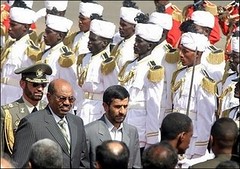
The Presidents of Sudan, Omar Hassan al-Bashir, and Iran, Mahmoud Ahmadinejad, viewing a military formation. Both nations are rich in oil and have been targeted by the United States and Britain for regime change.
Originally uploaded by Pan-African News Wire File Photos
By Stephen Gowans
Zimbabwe Herald
THE New York Times and US politicians are, through assertion and repetition, attempting to create as common knowledge the idea that Iran has a nuclear weapons programme and that the last presidential election in Iran was fraudulent, even though there is no evidence to back either claim.
In the November 23, 2009 New York Times edition, reporter Alexei Barrionuevo writes that "Brazil’s ambitions to be a more important player on the global diplomatic stage are crashing headlong into the efforts of the United States and other Western powers to rein in Iran’s nuclear arms program" (my emphasis.)
This treats the existence of a nuclear arms program in Iran as an established finding.
Yet, Tehran denies it has a nuclear weapons programme and the UN nuclear watchdog, the International Atomic Energy Agency, says it "‘has no concrete proof’ that Iran ever sought to make nuclear arms…"
The 2007 US National Intelligence Estimate disagrees, in part, claiming that Iran had a nuclear weapons programme in 2003, but says that Iran has since disbanded it. In February, "US officials said that… no new evidence has surfaced to undercut the findings of the 2007."
According to the head of the IAEA, Mohamed ElBaradei, the agency has "not seen concrete evidence that Tehran has an ongoing nuclear weapons programme . . . But somehow, many people are talking about how Iran’s nuclear program is the greatest threat to the world… In many ways,
I think the threat has been hyped.
Yes, there’s concern about Iran’s future intentions and Iran needs to be more transparent with the IAEA and the international community . . . But the idea that we’ll wake up tomorrow and Iran will have a nuclear weapon is an idea that isn’t supported by the facts as we have seen them so far."
Barrionuevo isn’t alone in asserting, without evidence, that Iran is building nuclear arms. US Representative Eliot Engel, chairman of the House Subcommittee on the Western Hemisphere, told Barrionuevo that "the world is trying to figure out how to prevent Iran from having nuclear weapons", assuming, as a given, that Iran is trying to have nuclear weapons.
Engel also says that Iran’s president Mahmoud Ahmadinejad "is illegitimate with his own people," a reference to the disputed presidential election Iran’s opposition claims Ahmadinejad won through fraud.
Barrionuevo points to critics who worry that a visit to Brazil by Ahmadinejad will "legitimise" the Iranian president "just five months after what most of the world sees as his fraudulent re-election."
Yet there is no evidence the election was stolen.
All that backs the allegation is the assertion of the opposition that the election was fraudulent and "what most of the world" believes, this being based on the Western media treating opposition claims as legitimate.
This is a circular process. Most of the world believes the election was fraudulent because that’s what the principal source of information on this matter, the media, led it to believe. Now the New York Times offers the fact that the assertion is widely believed as evidence it is true.
This might be called the bootstrap theory of propaganda: legitimise an assertion by treating it as true, and when most of the world believes it’s true, offer the reality that everyone believes it to be true as evidence it is.
The only relevant evidence that would allow us to determine whether the outcome of the election was crooked or fair is provided by the sole methodologically rigorous poll conducted prior to the election.
It was sponsored by the international arm of the US Republican Party, the International Republican Institute, hardly a booster of Ahmadinejad. Carried out three weeks prior to the election, the poll "showed Ahmadinejad leading by a more than 2 to 1 margin – greater than his actual apparent margin of victory".
The pollsters, Ken Ballen and Patrick Doherty, concluded that "Ahmadinejad is who Iranians want." The process of creating commonly held beliefs that have no evidentiary basis, and doing so through assertion and repetition, is not new.
To justify an illegal war on Yugoslavia, Western politicians, and the Western media in train, asserted without evidence that genocide was in progress in Kosovo in 1999.
Tens of thousands of corpses were expected to be found littering the "killing fields" of the then-Serb province. But when forensic investigators were dispatched to Kosovo after the war to document the genocide, the bodies never turned up.
By frequently repeating unsubstantiated claims, people were led to believe that systematic killings on a mass scale were being carried out, and that the West had a moral obligation to intervene. The public was duped.
Similarly, Western politicians "sexed up" intelligence on weapons of mass destruction to justify the 2003 invasion of Iraq.
The Western media went along; acknowledging only after public support for the war had been engineered by the media’s propagation of US and British government lies, that it had got it wrong. The politicians said they had been misled by the CIA. The CIA said it was pressured by the politicians. All that mattered was that many people believed that Saddam Hussein was hiding banned weapons. When none were found, a new pretext for dominating Iraq militarily was trotted out, and acceptance of the pretext was aided by the repetition of more unsubstantiated assertions.
The bootstrap theory of propaganda is at work again, this time in connection with Iran.
Stephen Gowans is a Canadian writer and political activist resident in Ottawa. This article is produced from gowans.wordpress.com.
No comments:
Post a Comment